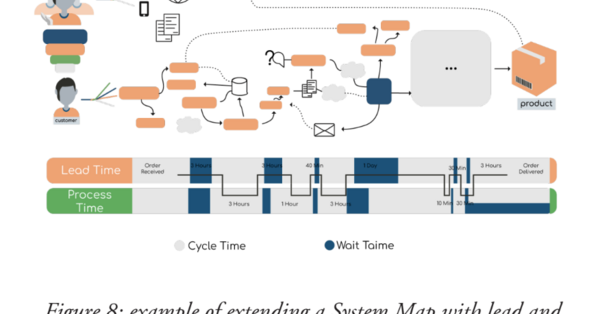Overview
It’s a common exercise in the Agile arena to surface any potential improvement in our day-to-day processes. It comes from the lean manufacturing revolution that makes things visible by embedding materials and information on flow diagramming to introduce lean practices.
The idea is to bring together representatives of each vertical section of your System Map and collaborate to outline time spent in between each vertical area (think of it being in a queue ready to be consumed by the next vertical step), where you co-create ways to streamline it.
In Figure 8, the relationship between lead time and process time is shown. The top part of the diagram is a diagram of the process. As mentioned earlier on the left is an image representing the customer and on the right is the final product. In between are all the processes required to create the product. There is an additional line looping back to the world, sales and prospective customers. Below are two bars, one showing lead time and the other process time. This outlined the time spent working on parts of the product development, design and production, and waiting times in between each of these steps. For example, an order is received but it is three hours before the first part of the process begins. This process may take three hours, followed by a three hour wait time which incurs a delay before the next step in the process. Figure 8 shows eight periods of lead time, or delay between the six periods of process time. The aim of lean manufacturing is to minimise these wait times in order to shorten the overall time needed between the order being received and delivered.
You may have already started! Pick up your System Map. And enrich it with variables beyond 'time'; include materials and energy, find the leverage points and how can you streamline it throughout your whole value chain.





Tom Owen-Smith
Lambeth, London Borough of Lambeth, England, United Ki...
I’m keen to learn and share ideas on applying Doughnut Economics in my own life and for universities and higher education